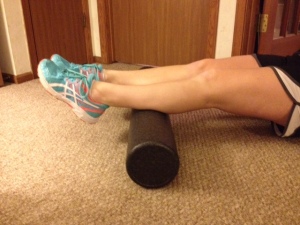Today’s post is the last post of a 3 part series that has talked about running injuries. Hopefully you have found the first two useful and if you missed them, read them here: Part 1 and Part 2. I’m excited to talk alittle bit about injury prevention today because it makes me feel great when I see people be able to continue with what they love!
The main running injuries that I’ve talked about have been knee pain aka patellofemoral pain, plantar fasciitis, shin splints, and iliotibial band syndrome. As a side note, a lot of these issues can be caused by one thing and are commonly associated together. With that being said, I am going to try to break it down by each injury but there is quite a bit of overlap.
Knee pain (patellofemoral pain): This is the most common injury that runners experience (myself included!) and typically is due to muscle weakness and poor patellar tracking. Shortening your stride while running can decrease the loads placed on the knee joint, ultimately leading to no pain. To address the deeper issue, it’s important to strengthen the glutes in order to control the knee position. Try this exercise: Lie on your side with hips stacked on top of each other and knees bent. Lift the top knee up in the air but keep feet together. Repeat x 15. Then lift the entire top leg up in the air for 15 reps. Then, start with the top leg in the air and rotate the foot up without moving thigh. Do 15 reps like this then repeat on the other side.
Plantar fasciitis and shin splints: These two injuries are prevented more from proper training programs and the correct shoe fit. The easiest way to prevent these from happening, and from returning, is to increase mileage gradually. It’s also important to perform adequate calf stretching and/or foam rolling to maintain mobility which will also decrease your risk for re-injury. Check out how to foam roll your calves:
Iliotibial band syndrome: Lastly, the IT Band syndrome frequently occurs in conjunction with knee pain and that’s partly because tightness in the IT Band will create improper patellar tracking, therefore creating knee pain. Similar to preventing knee pain, you can prevent IT Band syndrome by strengthening the glutes in order to promote better alignment. The same exercise shown above will also apply but progressing to single leg squats will continue to strengthen the hip muscles. Foam rolling is also a great method to help keep this loose and decrease friction. To foam roll, lie on your side with the outside of your thigh resting on the foam roller. With the leg straight, roll up and down along the length of the thigh. Focus more on areas that create more discomfort or areas that you experience pain.
Another great option for runners is to have an actual slow-motion, running analysis done by a qualified professional. This will show you the areas of concern that are specific to you and can give you a more focused plan to prevent or resolve injuries. It may be difficult to find a Physical Therapist in your area that does this so let me know if I can help you in any way. If you are in the Milwaukee area, let me know if you would be interested in learning more about them at FitandTonedWI@gmail.com. And obviously there are a lot of additional injuries that I did not cover so if you have a specific questions, feel free to email or comment! Happy running!





I had the same problem, my shin splints flair from like a dull sensation to like a ten when ever I ran, I received physio for it but the best way is to know what actually causes your pain in shins. I started to look for a solution and after some years I decided to collect all what I learned in that years of pain and from the people I helped (I’m a personal trainer). I have started a blog where I write articles about shin splints and other common runner’s injuries, feel free to check it out!
LikeLike